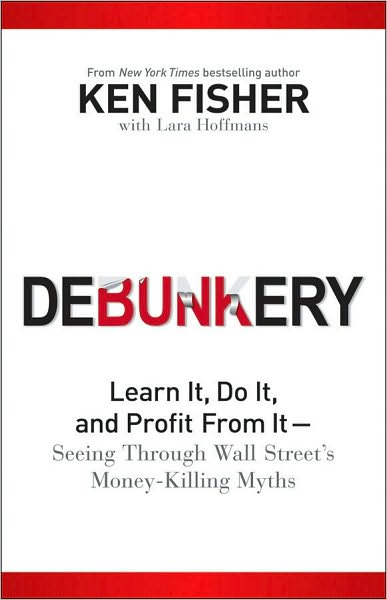Ken Fisher and Lara Hoffmans write well.? This book is accurate (with a few quibbles), and succinct.? I know these topics well; it took me less than three hours to read it.
There are many half-truths that travel around Wall Street.? There are still more that come from salesmen.? There are those that your investing friends will teach you.
Some come from the idea that the economy affects the markets in the short-run, or that good or bad policy will drive the market higher or lower.
Markets are far less predictable than we imagine.? They abhor simple rules.? Indeed the “rules” created in one cycle may be pure poison in the next one.
Also, absent war on your home soil, pestilence, plague and rampant socialism on a greater level than what Western Europe has seen, equity markets are pretty resilient.? Fisher’s native optimism has served him well in his lifetime.? There are few pessimistic millionaires.
That leads his asset allocation advice to be more geared to stocks, and more than the norm to foreign stocks.? (Which is good so long as the rule of law is maintained.)
In general, Fisher has written a very good book here.? The points are made briefly in an average of four pages each.? For those that want a quick introduction to the many fallacies on Wall Street, this book will do an excellent job.? After that, you can look to other books to fill in the details.
Quibbles
In Chapter 15, he mistakes immediate annuities for fixed annuities.? Immediate annuities are annuities that are paying out now.? Fixed annuities are those that pay interest, whether they are immediate or deferred (not paying out now).
In Chapter 16, he talks about Equity Indexed Annuities.? He misses several things:
1) Growth is more typically guaranteed at 2-3%, not 6%.
2) He misses Asian design contracts, which offer higher participation in exchange for having the option pay out on average returns over a year.? People don’t get what they are giving up there, but it looks better to them.
3) The surrender charges are higher and longer than they are for other deferred annuity designs.
There are other details that I think he mangles, but in his main thrust he is correct in both chapters to steer people away from any annuity aside from immediate annuities for those who need income.? Anything the insurance company can do with annuities, you can do, and cheaper.
But if Mr. Fisher wants to write about life insurance products more, maybe he would like to get a life actuary on staff, or at least someone with the LOMA credential.
Aside from that, Mr. Fisher should read “This Time is Different” by Reinhart and Rogoff.? Government deficit levels are not a thing of indifference, though they will affect stocks less than long bonds.
My penultimate quibble is that many common sayings are true within limits.? The limits imply broader models that might be discovered by multivariate regression.? There is little of that in the book.
Finally, the rule should be sell in April, buy in October.? More at my blog, I have an article to write.
Who would benefit from this book:
Ordinary people who don’t have a lot of time to consider each issue would benefit from this book.? They get a broad amount of protection from a single book.? The lessons come quickly, and immunize investors against a lot of investing mistakes.
If you want to, you can buy it here: Debunkery: Learn It, Do It, and Profit from It-Seeing Through Wall Street’s Money-Killing Myths.
Full disclosure: I asked the publisher for this book, and they sent it to me.? I read and review ~80% of the books sent to me, but I never promise a review, or a? favorable review.
If you enter Amazon through my site, and you buy anything, I get a small commission.? This is my main source of blog revenue.? I prefer this to a ?tip jar? because I want you to get something you want, rather than merely giving me a tip.? Book reviews take time, particularly with the reading, which most book reviewers don?t do in full, and I typically do. (When I don?t, I mention that I scanned the book.? Also, I never use the data that the PR flacks send out.)
Most people buying at Amazon do not enter via a referring website.? Thus Amazon builds an extra 1-3% into the prices to all buyers to compensate for the commissions given to the minority that come through referring sites.? Whether you buy at Amazon directly or enter via my site, your prices don?t change.

